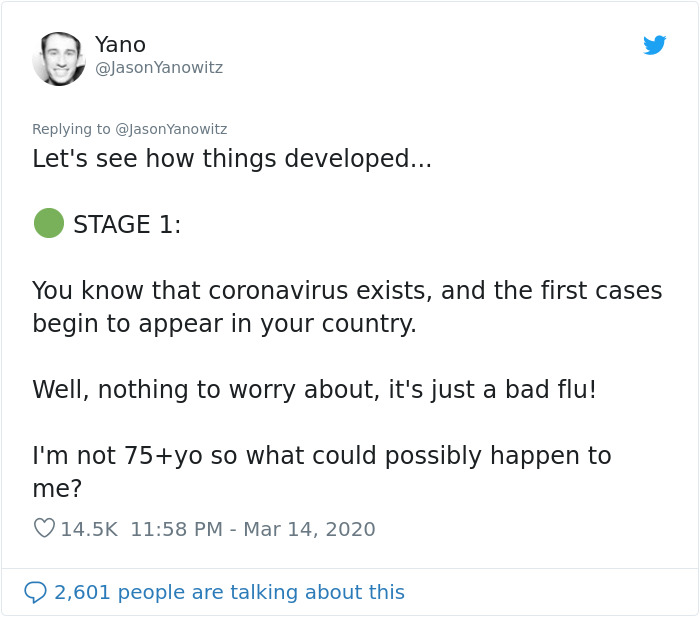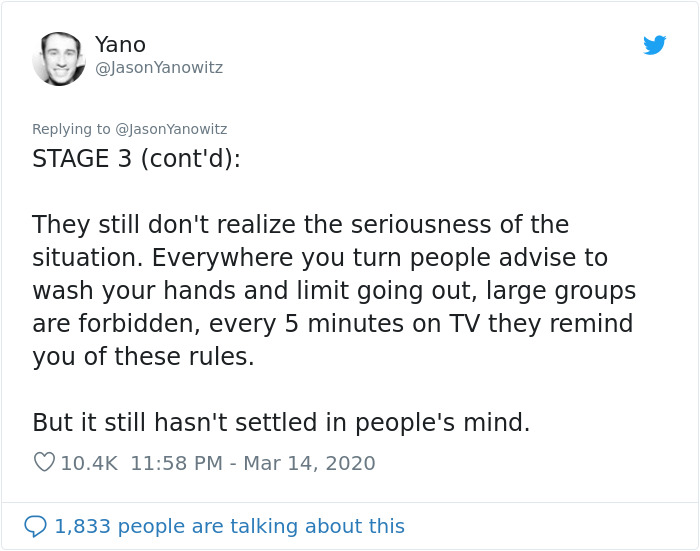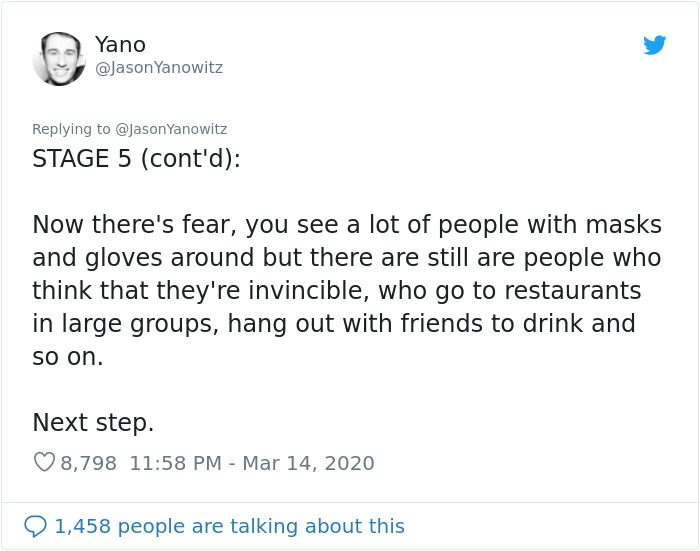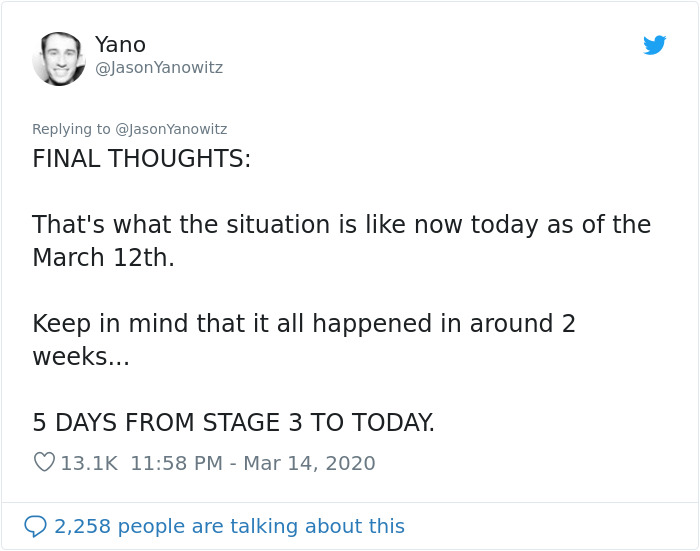This is an update of my
post Tuesday about my efforts to get tested for COVID-19 in Alaska.
My daughter, who's been monitoring this virus carefully, and has symptoms in Washington State, but can't get tested, is trying to see if it would be easier for me. If I'm negative, then she can let her daughter go back to school. If I'm positive, then she would meet the criteria of close contact with someone positive, so she can get tested. (My granddaughter has no symptoms, just her parents.)
So she sent me a link to
this State of Alaska Health Department Memo which includes this bit about Washington State:
"Testing Criteria for the State Public Health Laboratories The patient has a clinically compatible illness ANDo Close contact to a laboratory-confirmed case of COVID-19o OR a history of travel within the past 14 days to an affected geographic area(e.g.,the patient just returned from Northern Italy a week ago or Kirkland, WA 3 days ago)without an alternative explanatory diagnosis (e.g., influenza) ."
So, the State of Alaska is acknowledging that the Seattle area is 'an affected geographic area.'
But first I had to eliminate "an alternative explanatory diagnosis (e.g., influenza)."
So I'd emailed this all to the clinic and yesterday morning I had an email back from another doctor acknowledging my concern and saying to come in for a flu test.
"Just walk in" didn't sound like he was taking this seriously as a possible COVID case.
I called the clinic to check that the lab had me down. But as she got my travel info and symptoms again, she seemed to get more alarmed about my just walking into the clinic. I said I agreed. Could I just stay in the car and have someone come out and swab me? She said she might do that. But first she had to consult with the doctors.
She called back to say they want to consult with the state on my case. She wasn't able to get through to a person and left a message. I asked if I couldn't just get the flu test. She said they didn't have the COVID and I might need both. Then I'd have to go to the hospital.
She called back to say the state had said no to the test.
Let me remind you of the president's comments,
"Anyone who wants a test can get a test." I first emailed the doctor over the weekend. But I'm closer than I thought I'd be.
She had me come in at closing time when there wouldn't be others there and said she'd get me a mask and she'd be in protective clothing. My daughter had given us official masks as good-bye presents when we left Seattle, so I brought my own.
I got tested for influenza in one nasal passage and
RSV in the other. The influenza test results came back in minutes. Negative. The RSV will take a few days.
Then, since I'll have eliminated "alternative explanatory diagnosis," I should be able to ask again for a COVID test.
According to KTUU, the State of Alaska has 500 test kits. Yesterday the State Website said there had been 60 people tested, 0 positive tests, and 14 pending since January 1, 2020.
Today's update shows a slight different reporting method. Still 0 cases, but it doesn't mention how many are still pending, though there is one less test (59) than yesterday's 60 total tests given. And the new one identifies tests by the state v. tests by commercial or academic labs.
They don't tell us how many health care provider requests have been turned down.
And they don't tell us what they are saving the other 440 tests for. They could do 40 tests a day for ten days (assuming there are that many legitimate requests) and still have 40 more tests. In ten days there should be more tests available.
The point of testing is only in part to confirm that the high risk folks have COVID-19 and so health care workers can be protected when the patients come in for treatment. But for prevention, they need to track down and test all those who have been exposed and to identify those with lesser or no symptoms who would be spreading the virus because they have no symptoms.
The World Health Organization Report on China makes this recommendation for "uninfected countries" which is more or less where Alaska is for now:
"Immediately enhance surveillance for COVID-19 as rapid detection is crucial to containing spread; consider testing all patients with atypical pneumonia for the COVID-19 virus, and adding testing for the virus to existing influenza surveillance systems;"
I have a call into the state to see if I can get some answers about how many tests requests they turn down and why. But it doesn't look like they're calling back today, so I'll post this now.
[UPDATE March 12, 5pm: Well as soon as you stop waiting, it happens. I posted this and then a few minutes later I got a call-back. The volunteer nurse I spoke to, L, was terrific (211 gets you to health and social service questions, and they gave my number to be called back). Answered the questions she could and gave me another number to check on the ones she couldn't answer. She confirmed the change in format today because of the use of non-state labs and the difficulty of keeping the 'pending' number current. She couldn't tell me anything - other than the general criteria used to screen for testing - about the reasons people got turned down. She emphasized everything is in flux, every answer is 'just for now' because things are changing so fast, and she mentioned this afternoon's announcement of the closure of Anchorage schools for a week.
Is there a limit on the number of tests they can give a day? She didn't know.
Does the 500 tests include the 60 (or 59 today) already used? She was pretty sure that 500 was what the State got total.
When I asked if the State has a specific goal for its testing program, she gave me reasons for testing - to help those at high risk know if they are COVID or not, to alert family members if they have a COVID patient at home, and to generally lower the risk. When I pointed out that for public health stopping an epidemic, you needed to test lots of people until you find a few who were positive and then start testing all their contacts, she agreed. We don't have enough tests.
She was very knowledgeable, very open about what she knew and didn't know, and I thank her and the others for stepping up and volunteering to fill in this need with (at least in her case) caring responders. I'll try the number she gave me tomorrow]
[UPDATE March 12, 2020 6:56pm: And
Alaska's first case was announced after I posted the first update.]
Follow up post for Friday March 13, 2020 is here.
























Brilliant! Time for the hive mind to get to work...